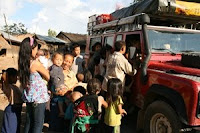We are now heading east towards Vietnam and Hanoi where we will visit friends.
After Hanoi, we hope to see a bit more of Vietnam before returning to Laos to explore the southern parts. From Laos we will cross into Cambodia, and then it is time to return to Thailand.
We plan to ship the car back to Sweden from Bangkok some time in July.
We will all fly home to Sweden in August in time for Ola’s sister’s wedding and the start of the next school year.
After Hanoi, we hope to see a bit more of Vietnam before returning to Laos to explore the southern parts. From Laos we will cross into Cambodia, and then it is time to return to Thailand.
We plan to ship the car back to Sweden from Bangkok some time in July.
We will all fly home to Sweden in August in time for Ola’s sister’s wedding and the start of the next school year.


















































